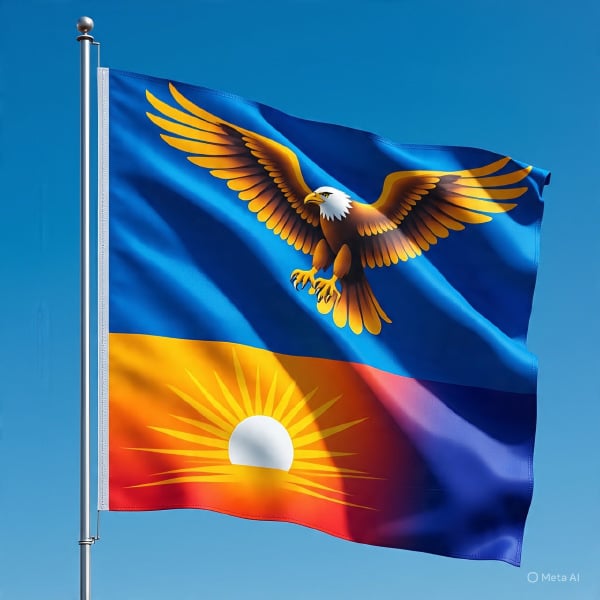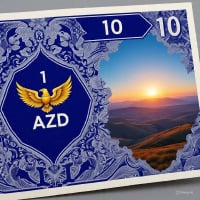This nation is in Vacation Mode for the next 401 turns. This nation cannot be attacked or traded with during that time.
| National Factbook |
| Flag: |

|
| Nation Name: |
The State of Azmara |
| Leader Name: |
Amara Elenora I |
| Currency: |

Azmaran Dollar |
| National Animal: |

Coron |
| History: |
The State of Azmara is a young nation with ancient roots. Though officially founded today, its story stretches far beyond its formal establishment woven through the legacies of a noble house and a people determined to carve their own destiny amidst the chaos of a fractured region.
For centuries, the bloodline of House Saerwyn endured in exile, scattered across the borderlands of Asia. The Saerwyns were once rulers of a proud and prosperous territory, but the tides of empire and conquest pushed them from their ancestral lands. Despite the hardships of displacement, the royal family preserved their traditions, their claim to sovereignty, and their vision of a united homeland.
The collapse of neighboring regimes and the rise of political instability in the region created a power vacuum and with it, an opportunity. Queen Amara Elenora I, the first monarch of the newly proclaimed State of Azmara, seized this moment with determination and clarity. Gathering loyal supporters and leveraging centuries of diplomatic networks, she declared Azmara’s independence, rejecting foreign interference and asserting absolute rule.
Azmara’s founding principles are rooted in order, sovereignty, and measured governance. The Queen’s vision was clear: to create a state that could resist the chaos surrounding it, build sustainable growth, and maintain the dignity of its people under an absolute monarchy. Social policies emphasize stability and unity over populism, while economic approaches balance innovation with tradition to ensure the nation’s independence.
Though small in land and population, Azmara is strategically positioned and fiercely protective of its sovereignty. The people, though few, share a deep loyalty to their Queen and a strong belief in the future of their nation. The State of Azmara does not yet command armies or influence great powers, but it is a rising force built on resilience, discipline, and unwavering ambition.
As Azmara steps onto the world stage, it faces challenges from regional rivals and global powers alike. Yet its resolve remains unshaken. Under Queen Amara Elenora I and the banner of House Saerwyn, Azmara aims to transform from a fledgling state into a respected kingdom a symbol of strength, tradition, and hope in an uncertain world.
|
| Geography |
| Continent: |
Africa |
| Land Area: |
56,777.52 sq. km |
| Terrain: |
Azmara’s landscape is defined by a mix of rugged mountains, rolling foothills, and fertile valleys. The mountainous regions provide natural fortifications and strategic high ground, making them ideal for defensive military positions. These peaks are dotted with ancient watchtowers and hidden passes, remnants of the state’s historical struggles and resilience.
The valleys and plains between the mountain ranges are rich with arable land, supporting agriculture and settlements. Rivers originating in the mountains flow through these fertile areas, supplying fresh water and creating natural borders within the country.
Along its limited coastline, Azmara has rocky cliffs and small harbors, offering access to maritime routes but requiring careful naval defense against possible incursions. The overall terrain presents a mix of natural barriers and accessible lands, favoring a defensive strategy but still allowing for economic development and infrastructure growth. |
| Highest Peak: |
Mount Virelorn,
3 meters
|
| Lowest Valley: |
The Seralin Valley,
150 meters
|
| Climate: |
Azmara experiences a temperate continental climate with distinct seasons. Winters are cold and crisp, especially in the mountainous regions where snowfall can be heavy, providing natural barriers against invasion. Summers are warm and relatively dry, creating favorable conditions for agriculture in the fertile valleys.
Spring and autumn bring mild temperatures and moderate rainfall, allowing for seasonal crops and replenishing the rivers that flow through the land. The climate supports a diverse range of flora and fauna, contributing to the nation’s near-pristine environment.
This climate demands adaptability from Azmara’s people and military, who are accustomed to both harsh winters and warm summers, shaping their resilience and strategic planning.
|
| People & Society |
| Population: |
2,895,426 people |
| Demonym: |
Azmaran |
| Demonym Plural: |
Azmarans |
| Ethnic Groups: |
Saerwyn - 80.0%
Vireli - 12.5%
Seralins - 8.1% |
| Languages: |
Azmaric - 85.6%
Virelian - 10.5%
Common Trade Tongue - 5.1% |
| Religions: |
Solarinism - 75.8%
Ancestor Veneration - 15.0%
Secular/Other - 10.0% |
| Health |
| Life Expectancy: |
76 years |
| Obesity: |
9.8% |
| Alcohol Users: |
32.4% |
| Tobacco Users: |
18.7% |
| Cannabis Users: |
26.9% |
| Hard Drug Users: |
1.2% |
| Economy |
| Description: |
The economy of the State of Azmara is young, tightly managed, and designed for long-term sustainability over rapid expansion. As a newly formed nation under the rule of Queen Amara Elenora I, Azmara’s economic philosophy is rooted in stability, self-reliance, and national sovereignty a deliberate counter to the volatility of neighboring regions and the overreach of global powers.
Azmara follows a mixed economic model. The state exercises strong oversight over critical sectors such as energy, defense production, and resource management while allowing limited private enterprise in agriculture, small industry, and urban commerce. The monarchy encourages entrepreneurship that aligns with national priorities, but places strict limits on foreign ownership, speculation, and unregulated markets.
The official currency is the Azmaran Dollar, a sovereign, state-issued currency pegged to a basket of regional assets and backed by resource reserves. This ensures moderate inflation and prevents dependence on foreign financial systems.
Despite its small size and population, Azmara’s geography provides significant economic potential. The fertile Seralin Valley serves as the heart of domestic agriculture, producing food staples, medicinal herbs, and a modest but growing export of wine, grain, and textiles. In the highlands, limited but valuable mineral deposits including copper, iron, and rare earths are mined under strict environmental regulations. Azmara’s clean air and low pollution levels are national points of pride, and industrial expansion is closely managed to preserve them.
Infrastructure development is a key focus of the Crown. The government has prioritized roads, irrigation systems, military-grade communication networks, and solar power installations. Long-term investments are being directed toward education, skilled trades, and domestic manufacturing, with the goal of minimizing foreign dependence and building national expertise from the ground up.
Trade is limited but strategic. Azmara maintains a small number of bilateral agreements, carefully negotiated to avoid economic coercion. Tariffs protect key sectors, and foreign investors must operate under strict licensing laws. The Crown is especially wary of foreign influence over food, water, and energy supplies considering them matters of national security.
Unemployment remains low, thanks to public works initiatives and state-backed cooperative programs. Wages are regulated, and essential services such as healthcare, education, and utilities are subsidized or directly managed by the monarchy. Corruption is minimal, due to the Queen’s personal oversight and a tightly controlled administrative structure.
In the long term, Azmara seeks strategic autonomy a future in which the nation can feed, fuel, and defend itself without bowing to global markets or foreign agendas. While the pace of growth may be slower than in more open economies, Azmara’s model emphasizes resilience over risk, discipline over debt, and loyalty over profit.
Under Queen Amara’s rule, the economy is more than a system it is an extension of national identity, shaped by duty, restraint, and the belief that true strength is built, not bought |
| Average Yearly Income: |
$47.30 |
| Gross Domestic Product (GDP): |
$2,483,382,253.00 |
| GDP per Capita: |
$857.69 |
| Gross National Income (GNI): |
$181,136,725.00 |
| Industries: |
Although Azmara is a young and compact nation, its economy is supported by a growing foundation of strategic, self-reliant industries designed to promote national strength, sovereignty, and long-term resilience. Under the absolute authority of Queen Amara Elenora I, all industrial development is directly overseen by the Crown through the Royal Ministry of Production and Trade, ensuring that every sector aligns with the broader national vision.
⚙️ 1. Agriculture & Agro-Processing
The Seralin Valley forms the heart of Azmara’s agricultural economy. Blessed with fertile soil and consistent seasonal rains, the valley sustains a variety of essential crops including wheat, barley, medicinal herbs, root vegetables, and olives. Livestock production primarily sheep, goats, and poultry is widespread in the southern lowlands.
The monarchy has invested in small-scale agro-processing facilities to ensure food self-sufficiency. Grain mills, canning centers, and textile-spinning cooperatives form a growing part of the rural economy, providing employment and strengthening Azmara’s food security. Pesticide use is minimal, and most farming is organic by default, aligning with the Crown’s environmental policies.
⛏️ 2. Mining & Resource Extraction
The northern highlands and mountainous regions around Mount Virelorn are rich in copper, iron, limestone, and trace amounts of rare earth elements. Though still in early stages, Azmara’s mining industry is tightly regulated, both to preserve the environment and to prevent exploitation by foreign actors.
All extraction licenses are issued by the Crown Mining Authority, and foreign companies are forbidden from holding direct ownership over natural resource projects. Minerals are used domestically for infrastructure and military development, with limited exports conducted through state-controlled trade routes.
⚡ 3. Energy Production
Azmara has committed to renewable energy from its inception. The country’s early investment in solar infrastructure, particularly in the southern plateaus, has allowed it to meet most of its internal power needs sustainably. The state also operates micro-hydroelectric facilities along river systems in the central regions.
Energy policy is nationally strategic the Queen considers energy independence a cornerstone of Azmara’s sovereignty. Private energy companies are not permitted; all infrastructure falls under the Royal Energy Commission.
🛡️ 4. Defense Manufacturing
Although small, Azmara maintains a growing defense industry. Under Queen Amara’s directive, local factories produce light arms, munitions, communications gear, and basic transport vehicles for the national military. The goal is to reduce dependency on foreign weapons systems and equip the Azmaran Royal Guard with domestically sourced tools.
The Crown encourages engineering and metallurgy schools to support this sector, and defense manufacturing is considered a patriotic industry one of the few sectors where state employees are granted special privileges.
🏗️ 5. Construction & Infrastructure
With the nation still under rapid development, construction remains a vital industry. Public works roads, military outposts, irrigation channels, civic buildings, and housing are funded directly by the state, employing large portions of the workforce. Traditional building methods are often combined with modern engineering, giving Azmara’s towns a blend of regal and practical architecture.
🛠️ 6. Crafts, Artisan Goods & Light Manufacturing
Azmara’s culture prizes handmade craftsmanship. The Vireli and Seralin ethnic groups in particular are known for their woodworking, metalwork, and handwoven textiles. These goods form a small but meaningful export sector and reflect Azmara’s emphasis on cultural identity and local production.
Light manufacturing also includes tools, clothing, ceramics, and basic electronics, mostly for internal use. The monarchy supports artisan guilds through grants and royal endorsements.
Final Note:
Azmara’s economy is not designed for mass consumption or foreign reliance. Instead, it is built on the principles of discipline, balance, and national control. Industries are judged not by profit alone, but by how well they serve the people, the land, and the Crown. In every sector, the message is clear: Azmara builds for itself. |
| Military |
| History: |
Loyal to the Crown. Ready for the Storm.
The Armed Forces of the State of Azmara, formally known as the Royal Azmaran Defense Command (RADC), serve as the shield of the Crown and the sword of national sovereignty. Though Azmara is young and modest in size, its military doctrine is rooted in discipline, self-sufficiency, and readiness for asymmetrical conflict. Every soldier serves not only the state but the throne.
All forces swear allegiance directly to Her Majesty Queen Amara Elenora I, and the military is governed by the Royal Council of Defense, chaired by the Queen herself. Civilian oversight is non-existent; the armed forces are an extension of royal authority.
⸻
⚔️ 1. Royal Ground Forces (RGF)
The backbone of Azmara’s military, the Royal Ground Forces are a compact but elite standing army. Designed for defense, rapid deployment, and high mobility, the RGF is structured around light infantry, mountain units, and border security detachments.
Key features include:
• Specialized Mountain Infantry Regiments trained for high-altitude combat and ambush tactics around Mount Virelorn.
• Rapid Response Units stationed near border zones and critical infrastructure.
• Ceremonial Royal Guard, based in the capital, responsible for the protection of the Queen and state institutions.
Though not heavily mechanized, the RGF places high emphasis on discipline, hand-to-hand combat, and terrain-based tactics.
⸻
🛡️ 2. Azmaran Royal Guard (ARG)
An elite, handpicked force answering directly to the Queen, the Royal Guard functions both as a personal protective unit and an elite strike force. Members are chosen from among the most loyal and capable soldiers in the kingdom. They are trained in counter-intelligence, urban operations, and palace security.
Their presence is symbolic a reminder that the monarchy is never unprotected.
⸻
✈️ 3. Air Detachment Wing of the Crown (WC)
Azmara’s air force is small and in early development. Known as the Wing of the Crown, it currently operates a limited number of reconnaissance drones, utility helicopters, and light transport aircraft. Future plans aim to expand air defense capabilities through domestically produced unmanned systems and anti-air batteries.
Air superiority is not yet achievable, but strategic defense is prioritized around key sites such as the capital, military bases, and border zones.
⸻
⚓ 4. Naval Watch – The Azure Fleet
With a short but strategically vital coastline, Azmara maintains a small coastal defense navy called the Azure Fleet. Focused on patrol, surveillance, and deterrence, the fleet consists of:
• Light patrol boats
• Missile-equipped coastal defense platforms
• Maritime surveillance stations
Naval activity is closely monitored by the Royal Maritime Command, and foreign vessels near Azmaran waters are required to declare themselves or risk interception.
⸻
🛰️ 5. Cyber & Strategic Defense Division (CSDD)
Aware of modern threats, Queen Amara has invested in a specialized cyber defense division, trained in electronic warfare, digital surveillance, and data protection. This unit operates discreetly, guarding the nation’s communications infrastructure and intercepting threats before they escalate.
⸻
🪖 Conscription & Structure
Azmara maintains a volunteer force, though emergency powers allow for limited national conscription in wartime. Military service is seen as a noble path, especially among youth from rural regions and families loyal to the Crown. Basic training emphasizes physical endurance, loyalty, and mastery of Azmara’s terrain.
Final Notes
Azmara’s military is not designed to dominate great powers it is designed to survive them. Swift, loyal, and deeply rooted in national pride, the Royal Azmaran Defense Command is built to defend every inch of land, every subject of the Crown, and the legacy of the monarchy itself.
In Azmara, war is not waged for conquest.
It is prepared for survival. |
| Soldiers: |
270,000 |
| Tanks: |
12,211 |
| Aircraft: |
309 |
| Ships: |
146 |
| Missiles: |
9 |
| Nuclear Weapons: |
0 |
| Last Updated: 08/16/2025 11:00 pm |














